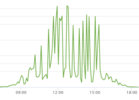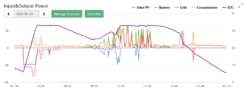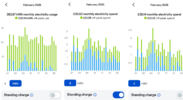What matters is the rate you get, at the moment I get nothing for export, but export rate can be from 6p to 26p per kWh, in the early days installers were offered more for export, than they paid for import, so there was no reason to try and store it.
I don't know if the deal is transferable, latter the export rates dropped, so it was a good idea to store energy in the DHW, I have an iboost+ which auto diverts power into my water once the export exceeds I seem to remember 200 watts, as we progressed further the export rate went much lower, and often you needed to have batteries to qualify for the export rate.
So a typical solar yesterday

with all those spikes it is near impossible to run anything other than immersion heater with iBoost off solar alone, to use just solar it needs some method to smooth out the spikes, so with a modern solar system, the battery is an essential part, so my use v import etc is

the purple line state of charge is the one I watch, as long as over 10% then unless I draw more than 5 kW then I will not use the grid power, but to do this needs an inverter designed to do it, my inverter holds back 10% for emergency, so with a power cut my freezers and central heating still works, and I also use off-peak as well as solar to charge the batteries, it is annoying to see 4.6 kWh exported for no payment, April my contract with British Gas ends and I will move to someone who will pay for export.
Internet said:
Yes, a solar panel payment for export deal, typically referring to payments under the Smart Export Guarantee (SEG), is generally transferable to a new owner if you sell your property.
The original agreements were for 25 years, and you were paid for having panels, they did not measure how much they exported. It was agreed what the average export would be, and you got paid that amount.
Then they fitted export meters, and you were paid only for how much exported, and now they insist on a smart meter, not as good with just solar panels, but with batteries as well, it at least has halved my electric bill even with no export payment. But each supplier has different rules, so with British Gas we get EV rate at night, Octopus you, it seems, need and EV and EV charger. Plus it changes area to area.




